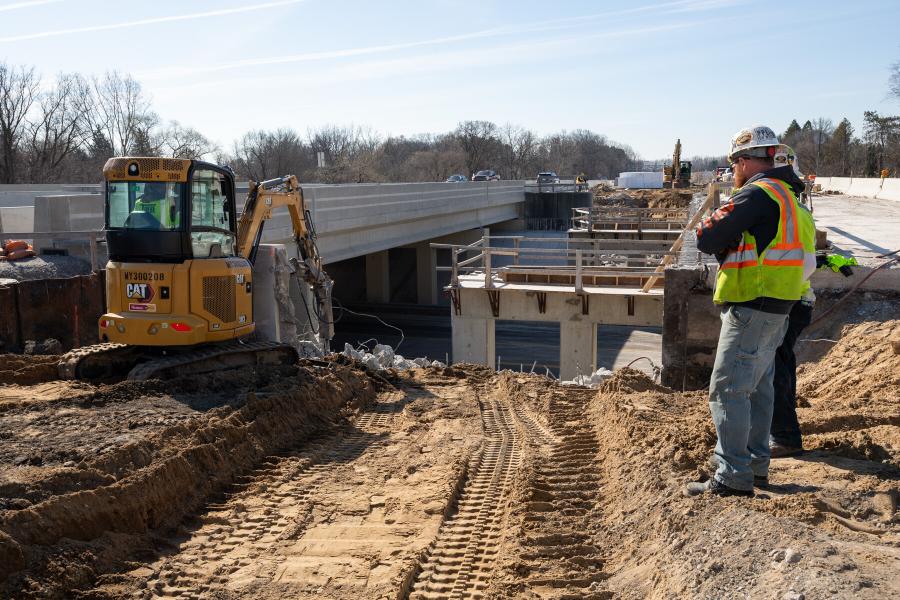
Toebe Construction Co. is leading a $205 million infrastructure improvement project on one of Michigan’s most heavily traveled commuter routes — the stretch of U.S. 127 between Interstates 496 and 69 — in an effort to enhance safety, traffic flow, and long-term durability. The project, part of the state’s Rebuilding Michigan initiative, is on track for completion this fall and represents one of the region’s largest current highway upgrades.

The 3.7-mile corridor runs through a vital section of the Lansing-East Lansing metropolitan area, connecting the Michigan State Capitol to the Michigan State University campus. The section handles thousands of vehicles daily, serving as a key artery for commuters traveling between Jackson, Detroit, and northwestern Michigan.
“It’s a major commuter route for everybody that goes anywhere north/south,” said Chris Gembel, assistant construction engineer with the Michigan Department of Transportation (MDOT). “If they're coming down to Jackson or perhaps traveling somewhere in Detroit, they're probably going to come through the area if they're up in the northwest part of Michigan. Likewise, if they're coming through the corridor west to east or east to west, 96 is how they travel. So, there's a lot of impacts not just for the community surrounding the project, but the motorists that come through.”
The project began in 2023 with an extensive maintenance of traffic (MOT) plan designed to minimize disruptions. Work on the northbound lanes was completed in 2024, and construction on the southbound lanes is now in progress. In total, the project involves 18 bridge structures, two large box culverts — one measuring 8-by-8 feet and the other 14-by-10 feet — and numerous structural rehabilitations.
Of the 18 bridges, six are undergoing full reconstruction, while the remaining structures are being partially rebuilt or rehabilitated. The project also includes the addition of a third lane for most of the route, expanding traffic capacity and improving safety.
“One of the main upgrades is we’re adding a third lane for the majority of the stretch of the project,” Gembel said. “All of the structures that are in between the southernmost part of the project and right up by the Trowbridge area needed to be widened, and so we’re basically adding a beam line on each of them. And then, obviously, you reconstruct that portion of the deck. We want to upgrade and rehabilitate the rest of the deck, and anything else that relatively warrants it. And then once we get up around the Trowbridge area, which is kind of a segue way into Michigan State University, and right where 127 splits off to Lansing, all those structures have come to the end of what you consider their service life. So, nearly all of those are being reconstructed, including the big ramp that goes into MSU. Those are full reconstructs.”
One of the project’s biggest challenges, Gembel said, is managing traffic flow at both ends of the corridor where it intersects with major freeways. With half of the ramps closed at any given time, drivers have faced detours and delays — but MDOT has made transparency and public communication top priorities.
“The biggest challenge on the project is that it intersects with two major freeways on both ends with half of the ramps closed at any given time,” he said. “That raises a lot of questions from travelers about the project and their restricted access. The best way to deal with the challenges is to make sure MDOT gets the word out about the project early and keeps the communication lines open during the project.”
Despite those hurdles, Gembel credited strong collaboration between MDOT and Toebe Construction for keeping the project moving efficiently.
“I think our partnership with the contractors made the project move just about as well as you could ask,” he said. “For the rest of us, it became almost the predominant workload to make sure that we’re satisfying what the public wants to see during construction. Being able to explain the why has always been the biggest challenge. I was very fortunate last year that the project, from a constructability standpoint, was running fluid.”
.jpg)
From large cranes to concrete mixers and heavy asphalt spreaders, the project site has become a showcase of modern highway construction technology.
“There is every piece of equipment that you can want for any build out there,” Gembel said. “This project has just about every element you can have in a construction project. We have huge culverts. We have structural rehabilitation, structural reconstruction. There’s both HMA [hot mix asphalt] and concrete. Although it is a concrete project, our maintenance of traffic is all HMA, so it’s a significant amount of HMA construction. I couldn’t tell you how many cranes they had out there, but there’s a lot, and last year, it was kind of a spectacle. It really made it look fantastic when you went through there … I don’t know that there’s a piece of equipment that wasn’t used.”
Once Toebe Construction wraps up this phase, MDOT plans two additional projects along the U.S. 127 corridor. The next will rebuild U.S. 127 from Lake Lansing Road to I-69, scheduled to go out for bid this fall. A subsequent project — rebuilding U.S. 127 from I-496 to Lake Lansing Road — is slated for 2027–2028.
Both fall under the Rebuilding Michigan program, a statewide effort “to rebuild the state highways and bridges that are critical to the state’s economy and carry the most traffic.” According to MDOT, the initiative emphasizes long-term fixes that extend infrastructure life, improve road safety, and enhance economic resilience for years to come.
Originally reported by Lori Tobias – CEG Correspondent in Construction Equipment Guide.